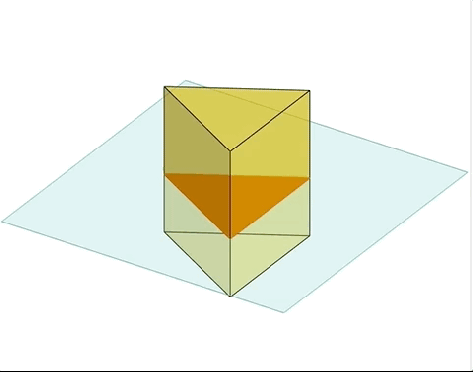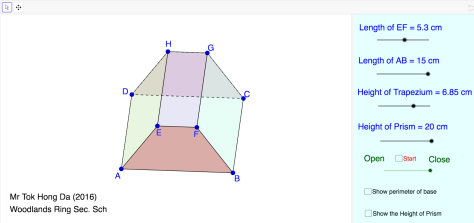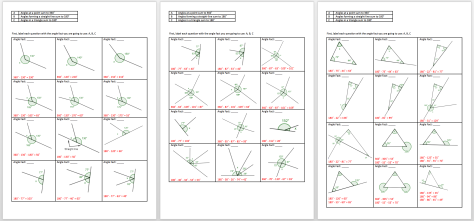I’ve learned to love routines since I started teaching and this term I am particularly pleased with the results I am seeing with a routine I have established around low-stakes testing, homework and lesson starters. A game-changer for me this year has been Hegarty Maths which my school uses for homework and has been integral to this routine and to encouraging and enabling pupils to take responsibility for their own learning. I have also been reading a lot more about spaced practice and have been sold on the idea of the testing effect and the power of low-stakes testing.
It won’t work for all: context is everything. My context is 3 x 1.5 hour lessons a week with a low attaining, small (15) but actually quite mixed Year 9 class with a high level of EAL. There are some pretty significant attendance issues with a handful of students who have been in about half of my lessons this year. And the usual challenges of lack of confidence / self-belief, reluctance to engage, poor learning behaviours, etc. that go with a bottom set.
It’s taken me a while to realise that the main obstacle to overcome for many learners is not so much understanding of new concepts but the retention of knowledge from one week to the next, one month to the next. It is not something I think I ever experienced at school, so I suffer from expert blindness and I struggle to empathise. Until recently, I used to get frustrated when I occasionally revisited topics with a class and they had “forgotten everything”. We want our pupils to see the deep connections between topics in mathematics as this goes some way to helping solidifying learning. But that is not sufficient for all pupils. Some will struggle to see the connections in the first place, for others those connections may have a transient impact and not have much impact on long-term memory.
This is where spaced practice comes in. Basically going over topics that include:
- Core skills that will have been taught since primary but are still not secure
- Topics from that last couple of weeks
- Topics from earlier in the year
So, our routine looks something like this:
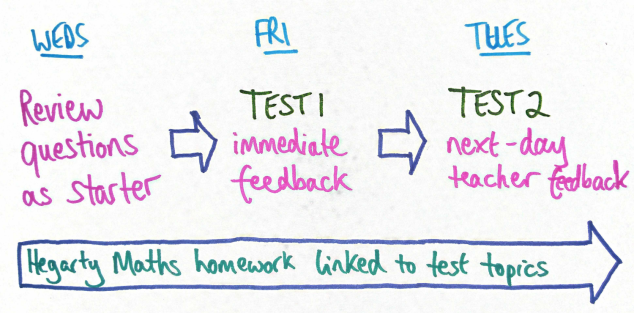
Wednesday: 5-6 starter questions on the board that I write. Here is an example:

There is overlap between these questions and the tasks that are set as Hegarty Maths homework for the week which is due the following Tuesday. I circulate the class to assess how they get on with these questions, what they have remembered and will maybe spend a bit longer doing some more of those questions on mini-whiteboards if I feel it will be helpful. This whole process could take anything between 15-30 minutes before reviewing Tuesday’s test (more about this later) and then getting into new learning and the main part of the lesson.
Friday: Knowledge Test 1. A single side of A4 with 12 questions which they do at the start of the lesson. Here is this week’s example:

I usually give them about 15 minutes which is long enough for highest attainers to attempt every question. The lower attainers have often stopped before then so I circulate and will give hints on mini-whiteboards and encouragement to them. We then review these questions immediately, they mark corrections with green pen and they keep the test paper to revise from. Each question has a Hegarty Task number on it. 3 of these tasks (the underlined ones) were set as the homework. They are encouraged to look up the other tasks if they need to revise them. The homework is set on Tuesday, due for the following Tuesday but I always make a point to praise pupils that have done the homework early, before the Friday test as they will have more success in the Friday test.
Tuesday: Knowledge Test 2. These questions are exactly the same topics / Hegarty tasks as Test 1. Here is the example from this week:
 So they know exactly what is coming up and should be able to get over 80% in this test. I tell them this and about two thirds of the class are now getting 70% or more. They do this one in silence, closed book. I offer minimal support, take them in at the end and mark them after school that day, which takes about 20 minutes.
So they know exactly what is coming up and should be able to get over 80% in this test. I tell them this and about two thirds of the class are now getting 70% or more. They do this one in silence, closed book. I offer minimal support, take them in at the end and mark them after school that day, which takes about 20 minutes.
Wednesday: Feedback on Test 2 after Starter questions as described above. This is usually pretty quick, around 5 minutes at most. After looking at their scores they then make corrections in green pen as I model solutions under the visualiser. With the result looking something like this.

The tests are then added to their folders so they are all kept together (rather than in books).
I toyed with the idea of giving detentions based on the result of Test 2, but I know there are some who would be getting a detention each week and that would be counter-productive. It also goes against the idea of low-stakes testing, i.e. the threat of a detention immediately makes it high-stakes and I already have some pupils with significant maths anxiety which I don’t want to make any worse. So I set detentions based on effort on homework which I can see clearly on Hegarty Maths. But I still give them the message that I expect them to be getting at least 10 out of 12 on Test 2.
The most obvious benefit so far has been completion of homework which has improved considerably. I’d like to think that I am gradually shifting the attitude of “I need get my Hegarty done to avoid a detention” to “I need to do my Hegarty so I can do well in my test”. Clearly I’d rather the predominant attitude to be “I want to do my homework as it will help my learning” but I think this is a step in the right direction!
Overall I guess this means that about 30% of lesson time is now being spent reviewing previous topics. That feels about right to me although it is significantly more than I used to do.
Do you do anything similar with your classes? Anything else you think that I should consider tweaking? Share ideas, please! Get in touch by leaving a comment or via Twitter. Please DM me if you’d like the full set of Knowledge Tests.
UPDATE: I have put the first 6 weeks’ test into a folder here. I do think the value is in tailoring these to your class, but also that this can be a bit time consuming. So if these are of use, please feel free to download, adapt, etc. I will try to add more as I make them.








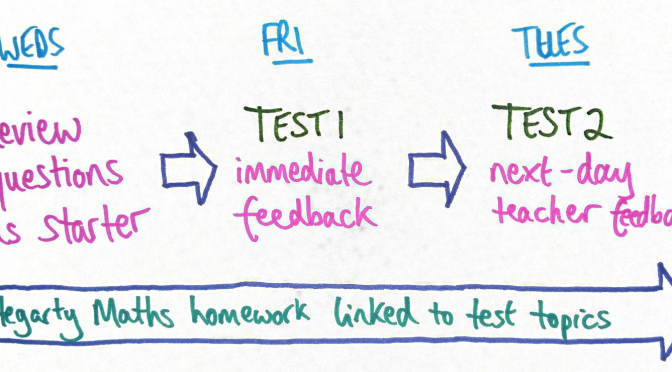



 So they know exactly what is coming up and should be able to get over 80% in this test. I tell them this and about two thirds of the class are now getting 70% or more. They do this one in silence, closed book. I offer minimal support, take them in at the end and mark them after school that day, which takes about 20 minutes.
So they know exactly what is coming up and should be able to get over 80% in this test. I tell them this and about two thirds of the class are now getting 70% or more. They do this one in silence, closed book. I offer minimal support, take them in at the end and mark them after school that day, which takes about 20 minutes.


